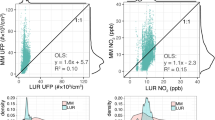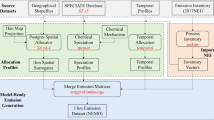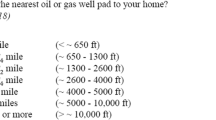Abstract
Polychlorinated dibenzo-p-dioxin and dibenzofuran (PCDD/F) emissions from industrial sources contaminate the surrounding environment. Proximity-based exposure surrogates assume accuracy in the location of PCDD/F sources, but locations are not often verified. We manually reviewed locations (i.e., smokestack geo-coordinates) in a historical database of 4478 PCDD/F-emitting facilities in 2009 and 2016. Given potential changes in imagery and other resources over this period, we re-reviewed a random sample of 5% of facilities (n = 240) in 2016. Comparing the original and re-review of this sample, we evaluated agreement in verification (location confirmed or not) and distances between verified locations (verification error), overall and by facility type. Using the verified location from re-review as a gold standard, we estimated the accuracy of proximity-based exposure metrics and epidemiologic bias. Overall agreement in verification was high (>84%), and verification errors were small (median = 84 m) but varied by facility type. Accuracy of exposure classification (≥1 facility within 5 km) for a hypothetical study population also varied by facility type (sensitivity: 69–96%; specificity: 95–98%). Odds ratios were attenuated 11–69%, with the largest bias for rare facility types. We found good agreement between reviews of PCDD/F source locations, and that exposure prevalence and facility type may influence associations with exposures derived from this database. Our findings highlight the need to consider location error and other contextual factors when using proximity-based exposure metrics.
This is a preview of subscription content, access via your institution
Access options
Subscribe to this journal
Receive 6 print issues and online access
$259.00 per year
only $43.17 per issue
Buy this article
- Purchase on Springer Link
- Instant access to full article PDF
Prices may be subject to local taxes which are calculated during checkout


Similar content being viewed by others
References
International Agency for Research on Cancer (IARC). IARC monographs on the evaluation of carcinogenic risks to humans. Polychlorinated dibenzo-para-dioxins and polychlorinated dibenzofurans; 1997.
International Agency for Research on Cancer (IARC). IARC monographs on the evaluation of carcinogenic risks to humans. 2,3,7,8-tetrachlorodiobenzo-para-dioxin, 2,3,4,7,8=ppentachlorodibenzofuran, and 3,3’,4,4’,5-pentachlorobiphenyl; 2012.
Viel JF, Arveux P, Baverel J, Cahn JY. Soft-tissue sarcoma and non-Hodgkin’s lymphoma clusters around a municipal solid waste incinerator with high dioxin emission levels. Am J Epidemiol. 2000;152:13–9.
Floret N, Mauny F, Challier B, Arveux P, Cahn JY, Viel JF. Dioxin emissions from a solid waste incinerator and risk of non-Hodgkin lymphoma. Epidemiology. 2003;14:392–8.
Viel JF, Daniau C, Goria S, Fabre P, de Crouy-Chanel P, Sauleau EA, et al. Risk for non Hodgkin’s lymphoma in the vicinity of French municipal solid waste incinerators. Environ Health. 2008;7:51.
Charnley G, Doull J. Human exposure to dioxins from food, 1999—2002. Food Chem Toxicol. 2005;43:671–9.
Domingo JL, Schuhmacher M, Muller L, Rivera J, Granero S, Llobet JM. Evaluating the environmental impact of an old municipal waste incinerator: PCDD/F levels in soil and vegetation samples. J Hazard Mater. 2000;76:1–12.
Floret N, Viel JF, Lucot E, Dudermel PM, Cahn JY, Badot PM, et al. Dispersion modeling as a dioxin exposure indicator in the vicinity of a municipal solid waste incinerator: a validation study. Environ Sci Tech. 2006;40:2149–55.
Lorber M, Pinsky P, Gehring P, Braverman C, Winters D, Sovocool W. Relationships between dioxins in soil, air, ash, and emissions from a municipal solid waste incinerator emitting large amounts of dioxins. Chemosphere. 1998;37:2173–97.
Deziel NC, Nuckols JR, Colt JS, De Roos AJ, Pronk A, Gourley C, et al. Determinants of polychlorinated dibenzo-p-dioxins and polychlorinated dibenzofurans in house dust samples from four areas of the United States. Sci Tot Evnrion. 2012;433:516–22.
Deziel NC, Nuckols JR, Jones RR, Graubard BI, De Roos AJ, Pronk A, et al. Comparison of industrial emissions and carpet dust concentrations of polychlorinated dibenzo-p-dioxins and polychlorinated dibenzofurans in a multi-center U.S. study. Sci Tot Evnrion. 2017;580:1276–86.
Malisch R, Kotz A. Dioxins and PCBs in feed and food—review from European perspective. Sci Tot Evnrion. 2014;491-492:2–10.
Pesatori AC, Consonni D, Rubagotti M, Grillo P, Bertazzi PA. Cancer incidence in the population exposed to dioxin after the “Seveso accident”: twenty years of follow-up. Environ Health. 2009;8:39.
Elliott P, Shaddick G, Kleinschmidt I, Jolley D, Walls P, Beresford J, et al. Cancer incidence near municipal solid waste incinerators in Great Britain. Br J Cancer. 1996;73:702–10.
De Roos AJ, Hartge P, Lubin JH, Colt JS, Davis S, Cerhan JR, et al. Persistent organochlorine chemicals in plasma and risk of non-Hodgkin’s lymphoma. Cancer Res. 2005;65:11214–26.
De Roos AJ, Davis S, Colt JS, Blair A, Airola M, Severson RK, et al. Residential proximity to industrial facilities and risk of non-Hodgkin lymphoma. Environ Res. 2010;110:70–8.
Pronk A, Nuckols JR, De Roos AJ, Airola M, Colt JS, Cerhan JR, et al. Residential proximity to industrial combustion facilities and risk of non-Hodgkin lymphoma: a case-control study. Environ Health. 2013;12:20.
Franzblau A, Zwica L, Knutson K, Chen Q, Lee SY, Hong B, et al. An investigation of homes with high concentrations of PCDDs, PCDFs, and/or dioxin-like PCBs in house dust. J Occup Environ Hyg. 2009;6:188–99.
Hinwood AL, Callan AC, Heyworth J, Rogic D, de Araujo J, Crough R, et al. Polychlorinated biphenyl (PCB) and dioxin concentrations in residential dust of pregnant women. Environ Sci Process Impacts. 2014;16:2758–63.
Richards G, Agranovski IE. Dioxin-like pcb emissions from cement kilns during the use of alternative fuels. J Hazard Mater. 2017;323(Pt B):698–709.
Tue NM, Suzuki G, Takahashi S, Kannan K, Takigami H, Tanabe S. Dioxin-related compounds in house dust from New York State: occurrence, in vitro toxic evaluation and implications for indoor exposure. Environ Poll. 2013;181:75–80.
U.S. Environmental Protection Agency (USEPA). An inventory of sources and environmental releases of dioxin-like compounds in the United States for the years 1987, 1995, and 2000. [Internet]. National Center for Environmental Assessment. Office of Research and Development. 2006. https://cfpub.epa.gov/ncea/risk/recordisplay.cfm?deid=159286 Accessed 3 June 2018.
Thomas VM, Spiro TG. Peer reviewed: the U.S. Dioxin inventory: are there missing sources? Environ Sci Technol. 1996;30:82a–5a.
Pollution prevention and compliance assistance information for the healthcare industry: incinerators: Healthcare Environmental Resource Center; 2015. http://www.hercenter.org/facilitiesandgrounds/incinerators.cfm.
U.S. Environmental Protection Agency (USEPA). www.epa.gov.
Energy Justice Network. www.energyjustice.net
Bao Y, Bertoia ML, Lenart EB, Stampfer MJ, Willett WC, Speizer FE, et al. Origin, methods, and evolution of the three nurses’ health studies. Am J Pub Health. 2016;106:1573–81.
Blair A, Thomas K, Coble J, Sandler DP, Hines CJ, Lynch CF, et al. Impact of pesticide exposure misclassification on estimates of relative risks in the agricultural health study. Occup Environ Med. 2011;68:537–41.
Cuellar AE, Gerler PJ. Trends in hospital consolidation: the formation of local systems. Health Aff. 2003;22:77–87.
Dosemeci M, Stewart PA. Recommendations for reducing the effects of exposure misclassification on relative risk estimates. Occup Hyg. 1996;3:169–76..
Healy MA, Gilliland JA. Quantifying the magnitude of environmental exposure misclassification when using imprecise address proxies in public health research. Spat Spatiotemporal Epidemiol. 2012;3:55–67.
Kirby RS, Delmelle E, Eberth JM. Advances in spatial epidemiology and geographic information systems. Ann Epidemiol. 2017;27:1–9.2.
Faure E, Danjou AM, Clavel-Chapelon F, Boutron-Ruault MC, Dossus L, Fervers B. Accuracy of two geocoding methods for geographic information system-based exposure assessment in epidemiological studies. Environ Health. 2017;16:15.
Acknowledgements
This work was supported in part by the Intramural Research Program of the National Cancer Institute (NCI), NCI Training Program in Cancer Epidemiology (T32 CA009001), and Susan G. Komen for the Cure® (IIR13264020). Dr. Deziel was supported in part by the American Cancer Society (grant MRSG-15-147-01-CNE).
Author information
Authors and Affiliations
Corresponding author
Ethics declarations
Conflict of interest
The authors declare that they have no conflict of interest.
Electronic supplementary material
Rights and permissions
About this article
Cite this article
Jones, R.R., VoPham, T., Sevilla, B. et al. Verifying locations of sources of historical environmental releases of dioxin-like compounds in the U.S.: implications for exposure assessment and epidemiologic inference. J Expo Sci Environ Epidemiol 29, 842–851 (2019). https://doi.org/10.1038/s41370-018-0079-0
Received:
Revised:
Accepted:
Published:
Issue Date:
DOI: https://doi.org/10.1038/s41370-018-0079-0
Keywords
This article is cited by
-
Integrating Shared Autonomous Vehicles into Existing Transportation Services: Evidence from a Paratransit Service in Arlington, Texas
International Journal of Civil Engineering (2022)



